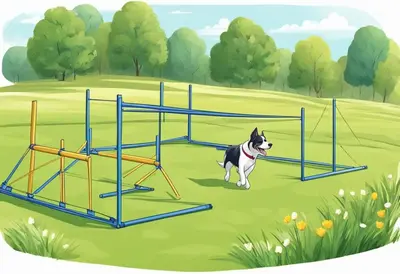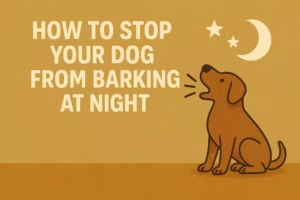Dog agility training is a fun and exciting way to keep your furry friend active and healthy. It is a sport that requires dogs to navigate through an obstacle course as quickly and accurately as possible. Not only does it help improve their physical fitness, but it also strengthens the bond between you and your dog.
To get started with dog agility training, it is important to have the right gear. This includes equipment such as jumps, tunnels, weave poles, and contact obstacles. While there is a wide range of equipment available on the market, it is important to choose the right gear that suits your dog’s needs and abilities. In this article, we will discuss the essential dog agility training gear that you need to get started with this exciting sport.
Key Takeaways
- Dog agility training is a fun and exciting way to keep your furry friend active and healthy.
- Having the right gear is important to get started with dog agility training.
- Choosing the right gear that suits your dog’s needs and abilities is crucial for their safety and success in this sport.
Understanding Dog Agility Training
Dog agility training is a competitive sport that involves a dog and its handler navigating an obstacle course in a set amount of time. It is a fun and challenging activity for both dogs and their owners. Agility training can help dogs develop their physical and mental abilities while also improving their obedience skills.
Agility training involves a variety of obstacles such as jumps, tunnels, weave poles, and A-frames. Dogs must navigate these obstacles in a specific order while following their handler’s commands. The goal is to complete the course in the fastest time possible with the fewest mistakes.
To get started with agility training, owners will need to invest in some essential gear. This includes agility jumps, tunnels, weave poles, and contact equipment. It is important to choose high-quality equipment that is safe for dogs and easy to set up and take down.
In addition to equipment, owners will also need to invest in training aids such as clickers, treats, and training leashes. These tools can help owners teach their dogs the basic commands and techniques needed to navigate the course successfully.
Overall, dog agility training is an excellent way to bond with your dog and help them develop their physical and mental abilities. With the right gear and training aids, owners can help their dogs become successful and confident agility competitors.
Importance of Physical Fitness in Dogs
Physical fitness is essential for dogs, just like it is for humans. Dogs that are physically fit are happier, healthier, and have a better quality of life. Regular exercise helps maintain a healthy weight, improves cardiovascular health, and strengthens muscles and bones.
One way to keep dogs physically fit is through agility training. Agility training involves a series of obstacles that dogs must navigate, such as jumps, tunnels, and weave poles. This type of training not only provides physical exercise but also mental stimulation, which is crucial for a dog’s overall well-being.
It is important to note that not all dogs are suited for agility training. Dogs that are too young, too old, or have certain health conditions should not participate in agility training. Additionally, dogs that are not properly trained or lack the necessary obedience skills may not be suitable for agility training.
To ensure a safe and effective agility training session, it is essential to have the right gear. This includes a sturdy collar or harness, a leash, and appropriate footwear for the handler. It is also important to have the right equipment for the dog, such as agility jumps, tunnels, and weave poles.
Overall, physical fitness is crucial for a dog’s well-being, and agility training is an excellent way to provide both physical exercise and mental stimulation. By using the appropriate gear and ensuring that the dog is suited for agility training, owners can help their furry friends stay healthy and happy.
Assessing Your Dog’s Current Fitness Level
Before starting any dog agility training program, it’s essential to assess your dog’s current fitness level. This will help you determine what types of exercises and equipment are appropriate for your pup.
One way to assess your dog’s fitness level is by checking their body condition score (BCS). The BCS is a numerical scale that veterinarians use to assess a dog’s body fat. The scale ranges from 1 (emaciated) to 9 (obese), with 5 being ideal. You can use a visual guide or palpate your dog’s ribs, spine, and waist to determine their BCS.
Another way to assess your dog’s fitness level is by observing their behavior during exercise. If your dog gets winded easily or has trouble keeping up, they may need to start with low-impact exercises before moving on to more advanced agility training.
It’s also important to consider any underlying health conditions that may affect your dog’s fitness level. For example, dogs with joint problems may need to avoid high-impact exercises like jumping.
Overall, taking the time to assess your dog’s fitness level before starting an agility training program will help ensure that they stay healthy and safe.
Essential Dog Agility Training Gear
Dog agility training is a fun and challenging way to keep your pup in shape. To get started, you’ll need some basic equipment. Here are some essential pieces of gear you’ll need to begin your dog’s agility training:
Jumping Equipment
Jumping is a key component of dog agility training. Dogs need to be able to jump over obstacles of varying heights and widths. There are many different types of jumping equipment available, including:
- Hurdles: These are the most basic type of jumping equipment. They consist of a bar that is supported by two uprights. The height of the bar can be adjusted to suit your dog’s ability.
- Panel Jumps: These consist of a solid panel that your dog must jump over. They are a good choice for dogs that are hesitant about jumping over bars.
- Tire Jumps: These consist of a hoop that your dog must jump through. They are a good choice for dogs that are confident jumpers.
Tunnels
Tunnels are another key component of dog agility training. They consist of a long, flexible tube that your dog must run through. Tunnels come in different lengths and diameters, so you can choose one that is appropriate for your dog’s size and ability.
Weave Poles
Weave poles are a challenging piece of agility equipment that require your dog to weave in and out of a series of poles. They are a great way to improve your dog’s agility and coordination.
Pause Tables
Pause tables are a flat platform that your dog must jump onto and then stay on for a set period of time. They are a good way to teach your dog to pause and wait for your instructions.
In conclusion, these are the essential pieces of gear you’ll need to begin your dog’s agility training. By starting with these basics, you’ll be able to build a strong foundation for more advanced training in the future.
Choosing the Right Equipment for Your Dog
When it comes to choosing the right equipment for your dog’s agility training, there are a few factors to consider. The first thing to keep in mind is your dog’s size and breed. Some equipment, such as jumps and tunnels, come in different sizes to accommodate different breeds and sizes of dogs.
Another factor to consider is your dog’s skill level. If your dog is just starting out with agility training, you may want to start with basic equipment such as weave poles and jumps. As your dog progresses, you can gradually introduce more advanced equipment such as tunnels and A-frames.
It’s also important to consider the type of surface on which the equipment will be used. Some equipment, such as weave poles and jumps, can be used indoors or outdoors on a variety of surfaces. However, other equipment, such as contact obstacles like the A-frame and dog walk, should only be used on a non-slip surface to prevent injury.
When choosing equipment, it’s also important to consider the quality and durability of the equipment. Look for equipment made from sturdy materials that can withstand regular use and exposure to the elements.
Lastly, consider your budget. Agility equipment can range in price from affordable to quite expensive. Keep in mind that investing in quality equipment may save you money in the long run by lasting longer and requiring fewer repairs or replacements.
By considering these factors, you can choose the right equipment for your dog’s agility training needs and help them stay fit and active.
File size
Training Your Dog to Use the Equipment
Once you have purchased the essential dog agility training gear, it’s time to train your pup to use it correctly. Training your dog to use the equipment takes patience, persistence, and consistency.
One of the most important things to remember when training your dog is to use positive reinforcement. Reward your pup with treats, praise, and playtime when they successfully complete a task. This will help to reinforce good behavior and encourage them to continue practicing.
Another key to training your dog to use the equipment is to start with the basics and gradually increase the difficulty level. Begin with simple tasks such as walking through a tunnel or jumping over a low hurdle. Once your pup has mastered these tasks, gradually increase the height of the hurdle or add more obstacles to the course.
It’s also important to keep training sessions short and fun. Dogs have short attention spans, so it’s best to keep training sessions to 10-15 minutes at a time. Make sure to incorporate playtime and plenty of breaks to keep your pup engaged and motivated.
Finally, be patient and consistent. Training your dog to use the equipment correctly takes time and practice. Don’t get frustrated if your pup doesn’t master a task right away. With patience and persistence, your pup will eventually become an agility pro.
Maintaining Your Dog’s Agility Equipment
Keeping your dog’s agility equipment in good condition is essential for their safety and performance. Here are some tips for maintaining your dog’s agility equipment:
1. Cleanliness
Regular cleaning of agility equipment is important to prevent the buildup of dirt, debris, and bacteria. Use a mild soap and water to clean the equipment, and make sure to rinse it thoroughly to remove any soap residue. Dry the equipment completely before storing it to prevent rust or mold growth.
2. Inspection
Regularly inspect your dog’s agility equipment for signs of wear and tear. Check for any cracks, loose bolts, or other damage that could compromise the safety of your dog. If you notice any damage, repair or replace the equipment immediately.
3. Storage
Proper storage is important to prevent damage to your dog’s agility equipment. Store the equipment in a dry, cool place to prevent rust or mold growth. If possible, store the equipment in a covered area to protect it from the elements.
4. Replacement
Agility equipment can wear out over time, especially with frequent use. It’s important to replace any equipment that is no longer safe or functional. Keep an eye on your dog’s equipment and replace it as needed to ensure their safety and performance.
By following these tips, you can help ensure that your dog’s agility equipment stays in good condition and provides a safe and fun training experience.
Monitoring Your Dog’s Progress
Once you have all the essential gear for dog agility training, it’s important to monitor your dog’s progress. Tracking your dog’s activity levels, sleep, and mood can help you determine if your training is effective and if your dog is healthy.
One way to monitor your dog’s progress is by using a dog activity tracker. These devices can track your dog’s steps, distance traveled, and calories burned. Some even offer GPS tracking, which can be helpful if you’re training your dog outdoors. The Tractive Waterproof GPS Dog Tracker is a top-of-the-line option that accurately reports your dog’s location with live GPS tracking, with updates every 2-3 seconds. Virtual fencing allows you to set safe spaces and receive notifications when your dog leaves and reenters.
Another way to monitor your dog’s progress is by keeping a training log. This can be a simple notebook where you write down the exercises you do with your dog, how long you do them for, and any notes about your dog’s behavior.
By keeping track of what you’re doing, you can see if your dog is improving over time. It can also help you identify areas where you need to focus more attention.
File size
In addition to tracking your dog’s physical progress, it’s also important to pay attention to their mood and behavior. If your dog seems lethargic or disinterested in training, it may be a sign that they need a break. On the other hand, if your dog is overly excited or anxious, it may be a sign that you need to adjust your training approach.
By monitoring your dog’s progress, you can ensure that your training is effective and that your dog is healthy and happy.








